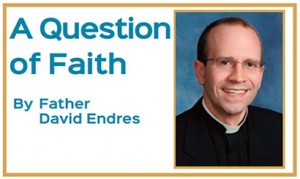What is the meaning of the memorial acclamation?
Q: I am bothered by the Mass response, “We proclaim your death, O Lord, until you come again.” To me it seems that we are attempting to lock Jesus back in the grave. I know there are some who say “God is dead,” but I never thought the church believed this.
A: During the Eucharistic prayer, immediately after the consecration, the congregation is invited to proclaim the “mystery of faith” (what is called the “memorial acclamation”). This short sung response is addressed to Christ, sacramentally present under the form of bread and wine, and is a joint affirmation by priest and people to what has just been prayed: “Take this, all of you, and eat of it, for this is my body . . . . Take this, all of you, and drink from it, for this is the chalice of my blood . . . Do this in memory of me.” The memorial acclamation – also called the anamnesis (from the Greek word meaning memorial) – highlights the liturgy as one of remembering Christ and what He has done for us, but not a reality frozen in the past but impacting the present and pointing to the future.
The Missal provides three options for the memorial acclamation. The first and second options include the phrase “we proclaim your death, O Lord.” The text for both is drawn from 1 Corinthians 11:26: “For as often as you eat this bread and drink the cup, you proclaim the death of the Lord until He comes.”
These short acclamations are not theologically complete themselves, for the death of the Lord but always be viewed in light of the resurrection. The first option for the acclamation makes this clearer, “We proclaim your death, O Lord, and profess your resurrection until you come again.” The second option, which you cite in your question, may seem to lose sight of the resurrection: “When we eat this Bread and drink this Cup, we proclaim your Death, O Lord, until you come again.” However, the reference to the Eucharist –“eat this bread and drink this cup” – must be seen in its full significance: that what we eat and drink is the body and blood of the risen Lord.
The acclamation is meant to encompass the fullness of the paschal mystery – Jesus’ life, death, and resurrection. Just as a crucifix does not negate belief in the resurrection, these acclamations are meant to connect Good Friday and Easter Sunday, recognizing their relationship and dependence. Similarly, they are not meant to be statements only about what Jesus did, but his continuing action in the world today by which He invites us to new life.
Perhaps it will be helpful to view the acclamation as not only a statement of belief about Jesus, but a challenge for us: to proclaim His life, death, and resurrection through our words and deeds; to foster gratitude for Jesus’ victory over sin and death; and to look forward with hope and joy to the resurrection which Christ’s life, death, and resurrection make possible.
As you note, the church rejects the once-popular saying, “God is dead,” instead heartily proclaiming that Jesus is alive – “resurrexit sicut dixit!” (He is risen as He said!). At every Mass, every time we sing the memorial acclamation, we proclaim Jesus’ promise of eternal life: that God is not dead, but fully alive, and because He lives, we can share in the hope of life eternal.
Father Endres is the dean of Mount St. Mary’s Seminary and the Athenaeum of Ohio. Send your question of faith to [email protected]














